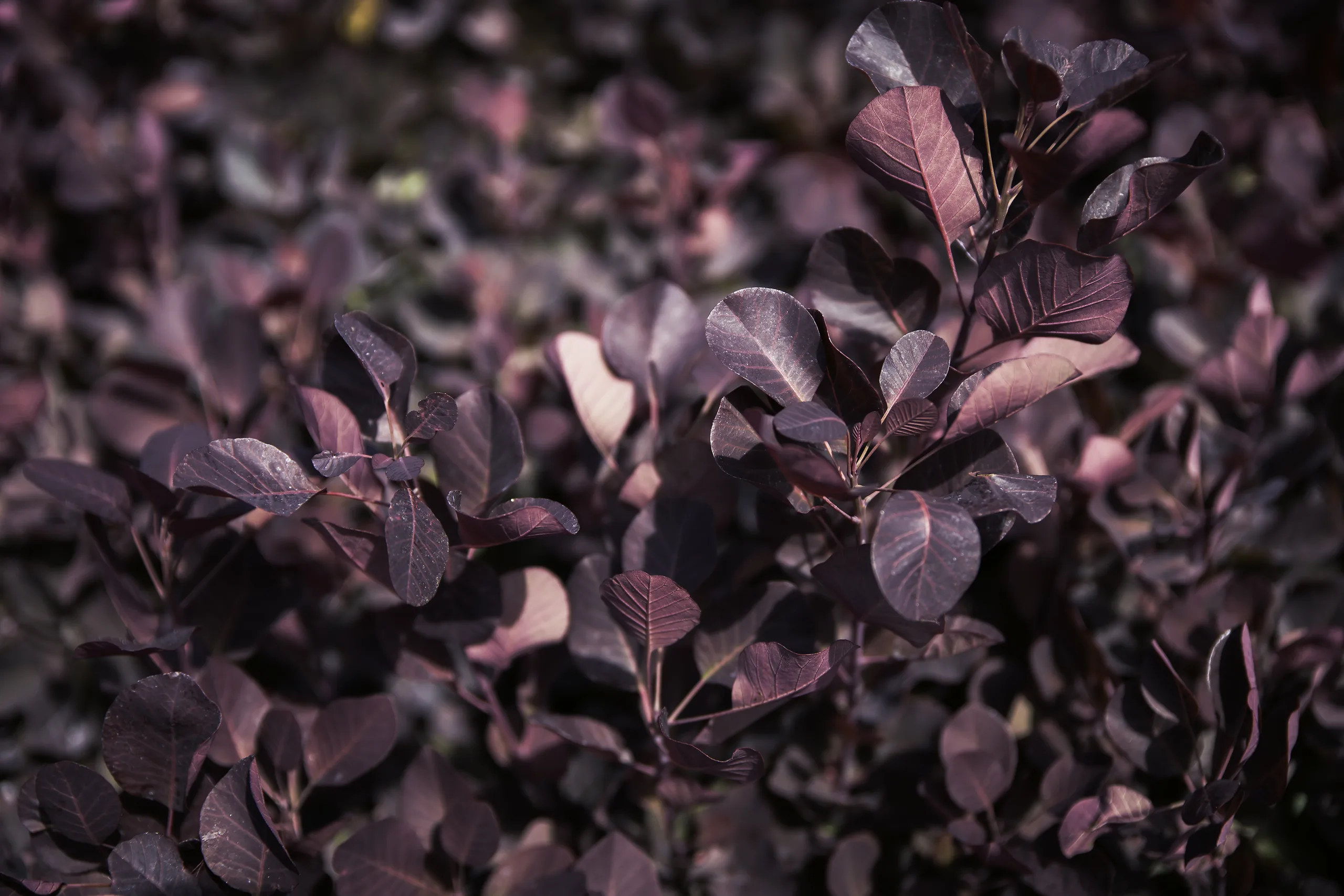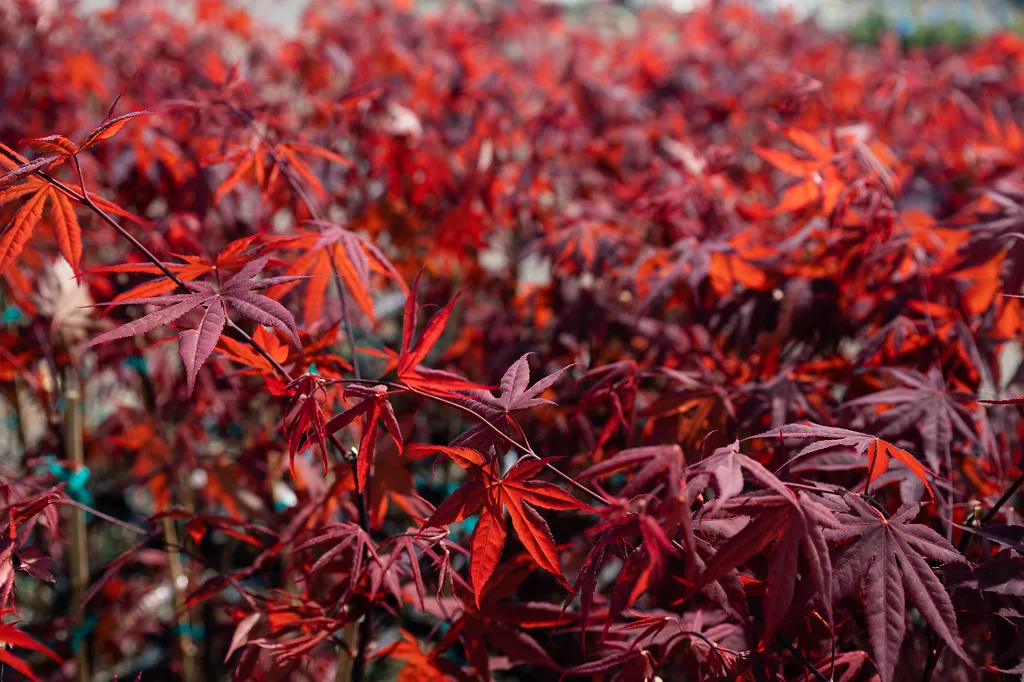
Written by s • Dark Foliage in the Garden – Use it Effectively
Everyone is using colored leaves in the garden these days – colored something other than green that is. Perhaps it is precisely because green is so ubiquitous that there is an eternal fascination with plants that don’t have green leaves, but whatever the reason, colored leaves are always popular. Colored leaves are usually either lighter – with areas of yellow, cream or white on them, or darker, typically dark reds to purples. They always sell well. Among the reds, the well-known Bloodgood Japanese Maple has been planted more than all other Japanese maples combined, it often seems. The Royal Purple Smoketree is another classic, and widely planted too. Other red-leaf trees like Beech or Crabapple are also big sellers, but unlike yellows and whites, which are hard to go wrong with, dark leaves are a little trickier, and using them well, so that they make the statement you were looking for, takes a little thought and planning.
What Makes Leaves Red?
The pigments that give us red leaves in spring and summer and the same as those that make apples red, give us red roses, and make the fall burn with color from red maples and oaks. These are anthocyanins, a water-soluble pigment found in the sap and cells of the plant. The amount produced, and when it is produced, combines to give us all the reds, purples and even pinks we see in leaves. A red leaf plant still has plenty of green in its leaves too, and it is changes in the concentration of green that create the various tones seen at different times in leaves. So in spring the new leaves are pale, with not much green chlorophyll, so the red is very pronounced, and new leaves may be pink, scarlet or crimson. As the chlorophyll content goes up – so that the leaves can photosynthesize and grow, the addition of green turns the red darker, creating purples and browner reds. The changes in chlorophyll concentration over the seasons mean that in the best red-leaf trees spring, summer and fall always feature different, often brilliant, changes in coloring.

In fall some plants break down the chlorophyll, to conserve the chemicals it is made of, and that takes all the green out of the leaf. The leaves turn yellow (the most common fall color), but if the leaf is already full of red, that will be all that is left, making for brilliant scarlets. In the right conditions a green tree may produce lots of anthocyanins in fall, turning green leaves red, rather than yellow.
Plant Them in the Sun
Red and purple leaves are, well, dark and the pigmentation is different from the brilliance of fall reds, so it is easy for them to slip into the shadows. Visually a dark leaf is an absence of color, not a presence, so with thoughtless planting you can end up creating a hole in your garden, so that the eye, rather than lingering to enjoy, instead moves on quickly in search of something more ‘eye-catching’ to look at. For this reason, the first ‘rule’ for planting these trees is to put them in the sun. The ideal place would be in a position where the sun is behind you when you look at them. That way the rays bounce off the leaves, bringing the color to your eye. If the sun is behind the plant, your iris will contract when you look in that direction, and you’re ability to perceive dark colors is seriously reduced when that happens. That lovely red-leaf plant is simply going to disappear. Sometimes red leaves also work well if the sun shines through them, making them glow and burn in the light. Remember, though, that is most likely to happen when the sun is low – in spring or fall – rather than in summer. Because of that, it works best for fall foliage, rather than for plants that are red through summer.
Sunlight Gives the Best Colors Too
Just as important as the aesthetics of it, placing red-leaf plants in the sun gives them the best coloring, and many will fade to more greenish shades when planted in darker places. At least 6 hours a day of direct sun is needed for most red-leaf plants.
Consider Where You Live
Remember too that red coloring is most intense in colder climates, at least for most red-leaf plants. In zone 8, they may be colorful in spring, but many turn greenish in summer. The search for reliable red foliage that stays in hot zones has led to such plants as the Summer Wonder Crab Apple tree, which does hold it rich red leaf-coloring all summer long, making it the perfect choice if you live in a warm zone.
Choose a Suitable Background
This is the most important thing to consider when planting a red-leaf tree or bush. You can really make a stand-out feature (or have a ‘color flop’), depending on what is behind the tree. If you have a dark brick house, don’t put a dark-leaf tree against it. Brick-reds have a lot of orange in them, while red-leaf trees are more towards purple, and those two types of red clash terribly. As well the dark background means there is no contrast, which is vital for the best display of dark leaves.
Contrast! Contrast! Contrast! should be your motto when planting these trees and shrubs. Plant with something appropriate behind – a white wall is perfect or use light foliage colors in the garden. For a suitable background, look for silver-blue foliage, light greens, or best of all, golds and whites. Yellow and purple is a classic color pairing of contrasting colors, and white always brighten the colors around it. When planning to use colored leaves in your garden – and you should make that plan – arrange your beds so that shrubs with yellow or variegated leaves go towards the back and plant the dark red leaves in the foreground. The secret is to put the dark color in front of a lighter one, not the other way round. If you have plants of similar sizes you can mix them together too, and this is especially effective if they are similar of the same plant. For example, a wonderful pairing can be made with the Black Lace Elderberry (Sambucus nigra ‘Eva’) and the Lemony Lace Elderberry (Sambucus racemosa ‘SMNSRD4’). These closely-related shrubs have very similar deeply-divided foliage, like large fern leaves, and they grow to a similar size – 3 to 6 feet tall. Plant Black Lace in front of a cluster of Lemony Lace or mix them together. Either way the effect is stunning. Perhaps you could finish such a planting with a foreground of a low-growing plant with large leaves – a blue Hosta perhaps – for a prize-winning combo. The Royal Purple Smoketree (Cotinus coggygria ‘Royal Purple’) and the Golden Spirit Smoketree (Cotinus coggygria ‘Ancot’) are another stunning pair.
Growing red-leaf plants is very rewarding, and the effects you can achieve are stunning. It just takes a little planning and forethought and you too can make the best use of these great trees.





